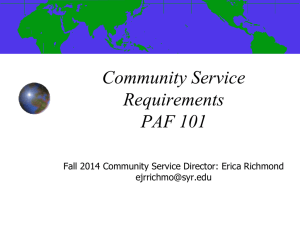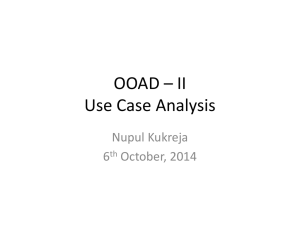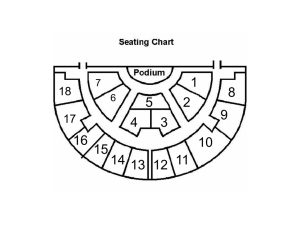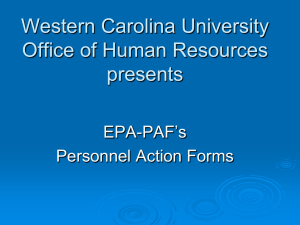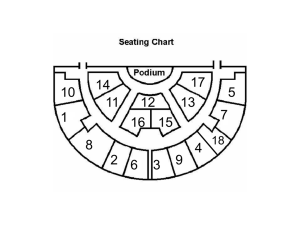RosenbergAndRankin_PAFs
advertisement
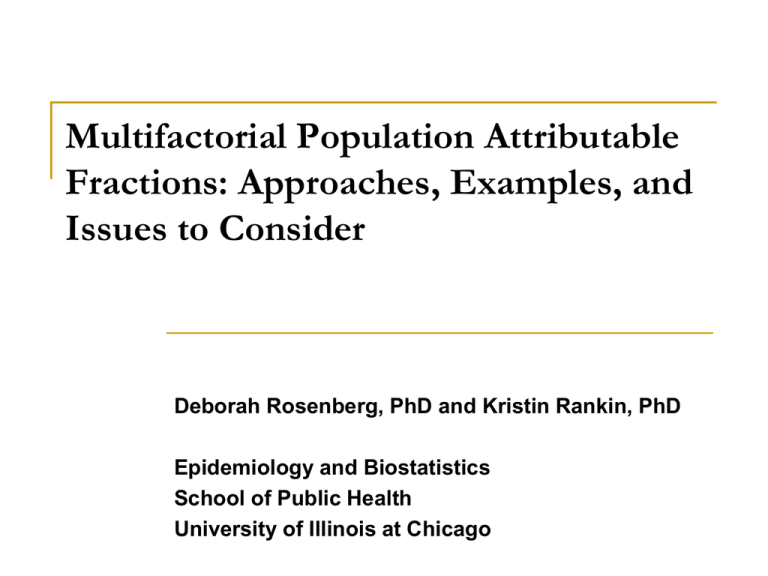
Multifactorial Population Attributable Fractions: Approaches, Examples, and Issues to Consider Deborah Rosenberg, PhD and Kristin Rankin, PhD Epidemiology and Biostatistics School of Public Health University of Illinois at Chicago Multifactorial Population Attributable Fractions: Approaches, Examples, and Issues to Consider Wednesday, May 30th, 3:15-5:00pm Deborah Research Rosenberg, PhD Associate Professor Kristin Rankin, PhD Research Assistant Professor Division of Epidemiology and Biostatistics University of IL School of Public Health Training Course in MCH Epidemiology Background In any multivariable analysis, the goal is to generate unconfounded / independent estimates of effect for each of many factors, taking into account the relationships among and intersection of those factors. Different analytic approaches are required to obtain these mutually exclusive estimates according to whether ratio measures of association or population attributable fractions (PAFs) are of interest. Background In contrast to relative risks or odds ratios the PAF is a function of both the magnitude of association and the prevalence of risk in the population The crude PAF (Levin, 1953): ProportionExposed RelativeRisk 1 AmongT hosewith theOutcome RelativeRisk Extension to a multivariable PAF RRj 1 p j RR j 0 j Rothman pj 1 j 0 RR j k k or Bruzzi 3 Background When estimating relative risks or odds ratios, independence can be achieved through use of usual adjustment procedures to control for confounding: “Does a risk factor confer excess risk of disease for an individual after holding all other factors constant?” When estimating PAFs, usual adjustment does not result in mutually exclusive PAFs, nor does it address the dynamics of how the prevalence of risk factors might change in the population over time “How much will eliminating a risk factor reduce the prevalence of disease in the population given that disease may still occur in the presence of other risk factors that have not yet been eliminated?” 4 Background After adjustment, both ratio measures and PAFs may be overestimates because of residual confounding. For PAFs, overestimation is of greater concern because simple adjustment assumes that only the factor of interest will be eliminated—its prevalence will be reduced to 0—while the prevalence of other factors remain constant. Concern about the precision of PAF estimates is also critical since these measures directly speak to the potential impact of public health action 5 Background Methods that go beyond the usual adjustment approach have been developed to handle the problem of obtaining mutually exclusive and mutually adjusted PAFs: Modifiable risk factors are considered together as belonging to what might be called a “risk system” − − Expected disease reduction due to elimination of any one risk factor is quantified by acknowledging every possible sequence for eliminating all factors in the “risk system” over time. the maximum expected disease reduction due to elimination of all risk factors in the “risk system” can also be appropriately quantified 6 Organizing Factors into a Risk System: A Framework for Computing PAFs “Adjusted” PAF: The PAF for eliminating a risk factor from a risk system after controlling for other factors (Miettenin, 1974) Summary PAF: The PAF for the maximum expected disease reduction when all factors in a risk system are simultaneously eliminated (Bruzzi, 1985) Component PAF: The separate PAF for every possible combination of exposure levels in the risk system (the set of joint and separate effects of risk factors) 7 Organizing Factors into a Risk System: A Framework for Computing PAFs Sequential PAF: The PAF for eliminating a risk factor in a particular order from a risk system; sets of sequential PAFs comprise all possible removal sequences Average PAF: The PAF summarizing all possible sequences for eliminating a single modifiable risk factor (Eide and Gefeller, 1995) 8 Organizing Factors into a Risk System: A Framework for Computing PAFs The Average PAF The AvgPAF for a risk factor is both mutually exclusive and mutually adjusted The sum of AvgPAFs for all modifiable risk factors in a system equals the summary PAF (sumPAF) for the risk system as a whole—the % of disease reduction expected if all of the factors are simultaneously and completely eliminated from the population 9 Example: Simultaneously Considering 3 Risk Factors for a Health Outcome Let 3 factors be called M1, M2, and M3 The SummaryPAF for this “risk system” can be partitioned into seven component PAFs: What is the proportion of disease attributable to each combination of risk factors? M1 and M2 and M3 M1 and M2 M1 and M3 M2 and M3 M1 alone M2 alone M3 alone 10 Summary PAF Partitioned into 7 Component PAFs 0.04 0.02 M1 & M2 & M3 0.06 M1& M2 0.02 M1& M3 M2 & M3 0.03 0.02 0.66 M1alone 3 Risk Factors for an Outcome Summary PAF = 0.34 M2alone M3alone 0.15 Unknown Joint and Separate Effects of M1, M2, & M3 Component PAFs still fail to provide a single estimate of the impact of each factor 11 Example: Simultaneously Considering 3 Risk Factors for a Health Outcome The SummaryPAF for this “risk system” can be partitioned six different ways into three sequential PAFs Computation of sequential PAFs involves a series of subtractions of adjusted and/or summary PAFs based on repeatedly redefining the risk system and its corresponding Summary PAF in terms of particular combinations of risk factors 12 Example: Simultaneously Considering 3 Risk Factors for a Health Outcome Six Sequences for Three Risk Factors Sequence #1: Eliminate M1, then M2, then M3 Sequence #2: Eliminate M1, then M3, then M2 Sequence #3: Eliminate M2, then M1, then M3 Sequence #4: Eliminate M2, then M3, then M1 Sequence #5: Eliminate M3, then M1, then M2 Sequence #6: Eliminate M3, then M2, then M1 For each factor, there are two 1st sequential PAFs, two 2nd sequential PAFs, and two 3rd Sequential PAFs. 13 Example: Simultaneously Considering 3 Risk Factors for a Health Outcome EXAMPLE (Sequence #1):Eliminate M1, then M2, then M3 1st SeqPAF* (M1) = PAF(M1) adjusting for M2 & M3 and other covariates** 2nd SeqPAF (M2) = SumPAF(M1 & M2) adjusting for M3 and other covariates – PAF(M1) adjusting for M2 & M3 and other covariates 3rd SeqPAF (M3) = SumPAF (M1 & M2 & M3) – SumPAF(M1 & M2) adjusting for M3 and other covariates *“adjusted” PAF **covariates are unmodifiable factors 14 Example: Simultaneously Considering 3 Risk Factors for a Health Outcome EXAMPLE (Sequence #5):Eliminate M3, then M1, then M2 1st SeqPAF* (M3) = PAF(M3) adjusting for M1 & M2 and other covariates** 2nd SeqPAF (M1) = SumPAF(M3 & M1) adjusting for M2 and other covariates – PAF(M3) adjusting for M1 & M2 and other covariates 3rd SeqPAF (M2) = SumPAF(M1 & M2 & M3) – (SumPAF(M3 & M1) adjusting for M2 and other covariates *“adjusted” PAF **covariates are unmodifiable factors 15 Summary PAF Partitioned into Sequential PAFs for Sequences #1 and #5 0.07 0.23 0.08 1st seqPAF M1 1st seqPAF M3 2nd seqPAF M2 2nd seqPAF M1 0.19 3rd seqPAF M3 3rd seqPAF M2 0.05 Unknown Unknown 0.66 1st , 2nd , and 3rd Sequential PAFs for the Sequence in which M1 is Eliminated First, M2 Second, and M3 Last 0.06 0.66 1st , 2nd , and 3rd Sequential PAFs for the Sequence in which M3 is Eliminated First, M1 Second, and M2 Last 3 Risk Factors for an Outcome: Summary PAF = 0.34 Sequential PAFs still fail to provide a single estimate of the impact of each factor 16 Example: Simultaneously Considering 3 Risk Factors for a Health Outcome In general: the number of possible sequences is a function of the number of factors in the risk system and becomes large quickly as the number of variables increases. # of Risk # of Possible Removal Factors Orderings / Sequences Number of Unique Sequential PAFs for a factor 2 2! = 2 2 3 3! = 6 4 4 4! = 24 8 5 5! = 120 16 6 6! = 720 32 7 7! = 5,040 64 17 Example: Simultaneously Considering 3 Risk Factors for a Health Outcome The SummaryPAF for this “risk system” can be partitioned into three average PAFs--one for each of the 3 factors The sequences are broken apart, rearranging the sequential PAFs so that the six 1st, 2nd, and 3rd sequential PAFs for M1 are grouped together as are those for M2 and M3 The AveragePAF for each factor is then calculated as the simple arithmetic average across the 6 sequential PAFs for each factor 18 Example: Simultaneously Considering 3 Risk Factors for a Health Outcome For example, the Average PAF for M1 is the sum of the following 6 Sequential PAFs divided by 6: The two 1st SeqPAFs for M1—Seq #1 & Seq #2 = PAF(M1), adjusting** for M2 & M3 (multiplied by 2) The two 2nd SeqPAFs for M1 —Seq #3 & Seq #5 = (SumPAF(M2 & M1), adj. for M3) – PAF(M2) adj. for M1 & M3 = (SumPAF(M3 & M1), adj. for M2) – PAF(M3) adj. for M1 & M2 The two 3rd SeqPAFs for M1 —Seq #4 & Seq #6 = (SumPAF(M1 & M2 & M3) – SumPAF(M2 & M3), adj. for M1 **Adjustment also includes covariates 19 Summary PAF Partitioned into Average PAFs for Three Risk Factors The avgPAF for a factor is the simple average of all of that factor’s seqPAFs 0.05 With 3 factors, the avgPAF 0.08 all 6 seqPAFs avgPAF M1 0.21 avgPAF M2 avgPAF M3 Unknown 0.66 Average PAFs for M1, M2, and M3 Accounting for All Sequences For Eliminating These Risk Factors 6 3 Risk Factors for an Outcome Summary PAF = 0.34 The Average PAF is a single estimate of the impact of each risk factor 20 Example: Smoking, Cocaine Use and Low Birthweight 21 Example: Smoking, Cocaine Use, and Low Birthweight: Crude Associations Crude RR = 10.00 = 1.60 6.25 200 1.6 1 Crude PAF 700 1.6 0.107 Crude RR = 30.00 = 4.77 6.29 90 4.77 1 Crude PAF 700 4.77 0.102 22 Smoking and Cocaine Organized into a Risk System If smoking and cocaine use were recoded as a single “substance use” variable: Freq | LOW BIRTHWEIGHT Row Pct | yes | no |Total _________|________|________| smoke and| 52 | 98 | 150 cocaine| 34.67 | 65.33 | _________|________|________| cocaine| 38 | 112 | 150 only| 25.33 | 74.67 | _________|________|________| smoke| 148 | 1702 | 1850 only| 8.00 | 92.00 | _________|________|________| neither| 462 | 7388 | 7850 | 5.89 | 94.11 | _________|________|________| Total 700 9300 10000 238 1.88 1 SummaryPAF 700 1.88 0.16 Freq | LOW BIRTHWEIGHT Row Pct | yes | no |Total __________|________|________| any smoke| 238 | 1912 | 2150 or cocaine| 11.07 | 88.93 | __________|________|________| neither| 462 | 7388 | 7850 | 5.89 | 94.11 | __________|________|________| Total 700 9300 10000 23 Component PAFs and Summary PAF for the Smoking-Cocaine Risk System Using Rothman’s formula: The Summary PAF is the sum of component PAFs 52 5.89 1 PAF3 700 5.89 0.062 RRj 1 pj RR i 0 j k 148 1.36 1 PAF1 700 1.36 0.056 + 38 4.30 1 PAF2 700 4.3 0.042 + + 462 1 1 PAF0 700 1 0.0 = 0.16 24 Limitation of Component PAFs from the Smoking-Cocaine Risk System While the component PAFs of a risk system sum to the Summary PAF for the system as a whole, they do not provide mutually exclusive measures of the PAF for each risk factor Coc Sm/Coc Here, the Summary PAF = 0.16, but the two factors overlap: the component PAFs still do not disentangle smoking and cocaine for those who do both Sm 0.042 0.062 0.056 0.84 25 The “Adjusted” PAF: Obtaining a Single PAF for a Given Risk Factor The Stratified Approach: The PAF for eliminating a risk factor after controlling for other risk factors With the Rothman formula, data are organized into the more traditional strata set-up for adjustment: Not assuming homogeneity, pj & RRj are stratum-specific: # of strata j # of e xpose dcase sj Re l ativeRiskj 1 Total C ase s,allstrata Re l ativeRiskj Assuming homogeneity, Overall # of exposedcases, all strata Adjusted RelativeRisk 1 T otalCases, all strata Adjusted RelativeRisk 26 The “Adjusted” PAF: Obtaining a Single PAF for a Given Factor Freq | LOW BIRTHWEIGHT Row Pct | yes | no |Total _________|________|________| smoke and| 52 | 98 | 150 cocaine| 34.67 | 65.33 | _________|________|________| cocaine| 38 | 112 | 150 only| 25.33 | 74.67 | _________|________|________| smoke| 148 | 1702 | 1850 only| 8.00 | 92.00 | _________|________|________| neither| 462 | 7388 | 7850 | 5.89 | 94.11 | _________|________|________| Total 700 9300 10000 Reorganizing the data to RR = 5.89 get an adjusted PAF with 52 5.89 1 PAF Rothman’s 700 formula 5.89 0.062 COCAINE=YES Freq | LOW BIRTHWEIGHT Row Pct| yes | no |Total _______|________|________| smoke| 52 | 98 |150 yes| 34.67 | 65.33 | _______|________|________| smoke| 38 | 112 |150 no| 25.33 | 74.67 | _______|________|________| Total 90 210 300 COCAINE=NO Freq| LOW BIRTHWEIGHT Row Pct| yes | no |Total _______|________|________| smoke| 148 | 1702 |1850 yes| 8.00 | 92.00 | _______|________|________| smoke| 462 | 7388 |7850 no| 5.89 | 94.11 | _______|________|________| Total 610 9090 9700 27 The “Adjusted” PAF: The PAF for Smoking, Controlling for Cocaine Use* 52 1.37 1 PAF 700 1.37 0.020 COCAINE=YES Freq | LOW BIRTHWEIGHT Row Pct| yes | no |Total _______|________|________| smoke| 52 | 98 |150 yes| 34.67 | 65.33 | _______|________|________| smoke| 38 | 112 |150 no| 25.33 | 74.67 | _______|________|________| Total 90 210 300 COCAINE=NO Freq| LOW BIRTHWEIGHT Row Pct| yes | no |Total _______|________|________| smoke| 148 | 1702 |1850 yes| 8.00 | 92.00 | _______|________|________| smoke| 462 | 7388 |7850 no| 5.89 | 94.11 | _______|________|________| Total 610 9090 9700 RR=1.37 + 148 1.36 1 PAF 700 1.36 0.056 = RR=1.36 PAF"Adjusted" 0.020 0.056 0.076 *Using stratum-specific estimates 28 The “Adjusted” PAF: The PAF for Cocaine Controlling for Smoking* 52 4.33 1 PAF 700 4.33 0.057 SMOKE=YES Freq | LOW BIRTHWEIGHT Row Pct| yes | no |Total _______|________|________| cocaine| 52 | 98 | 150 yes| 34.67 | 65.33 | _______|________|________| cocaine| 148 | 1702 |1850 no| 8.00 | 92.00 | _______|________|________| Total 200 1800 2000 SMOKE=NO Freq | LOW BIRTHWEIGHT Row Pct| yes | no |Total _______|________|________| cocaine| 38 | 112 | 150 yes| 25.33 | 74.67 | _______|________|________| cocaine| 462 | 7388 |7850 no| 5.89 | 94.11 | _______|________|________| Total 500 7500 8000 RR=4.33 + 38 4.30 1 PAF 700 4.30 0.042 = RR=4.30 PAF"Adjusted" 0.057 0.042 0.099 *Using stratum-specific estimates 29 Limitations of the “Adjusted” PAF: The resulting adjusted PAFs still are not mutually exclusive and they do not meet the criterion of summing to the Summary PAF for all factors combined 0.076 0.042 0.062 0.056 0.84 0.099 ≠ 0.042+0.062+0.056=0.16 0.825 0.076 + 0.099 = 0.175 30 Sequential PAFs (PAFSEQ) for the Smoking-Cocaine Risk System For the smoking-cocaine risk system, there are 2 possible sequences: 1. Eliminate smoking first (a), controlling for cocaine use, then eliminate cocaine use (b) 2. Eliminate cocaine use first (a), controlling for smoking, then eliminate smoking (b) And within each sequence, there are two sequential PAFs 31 Sequential PAFs (PAFSEQ) for the Smoking-Cocaine Risk System 1.The 1st sequential PAF for eliminating smoking first, controlling for cocaine use (the “adjusted” PAF): PAFSEQ1a (S|C) = 0.076 2.The 2nd sequential PAF for eliminating cocaine use after smoking has already been eliminated is the remainder of the Summary PAF PAFSEQ1b = PAFSUM – PAFSEQ1a (S|C) = 0.16 – 0.076 = 0.084 32 Sequential PAFs (PAFSEQ) for the Smoking-Cocaine Risk System 1. The 1st sequential PAF for eliminating cocaine use first, controlling for smoking (the “adjusted” PAF: PAFSEQ2a (C|S) = 0.099 2. The 2nd PAF for eliminating smoking after cocaine use has already been eliminated is the remainder of the Summary PAF PAFSEQ2b = PAFSUM – PAFSEQ2a (C|S) = 0.16 – 0.099 = 0.061 33 Sequential PAFs (PAFSEQ) for the Smoking-Cocaine Risk System By definition, the sequential PAFs within the two possible sequences sum to the Summary PAF, but they still do not provide single measures of the impact of smoking or cocaine use regardless of the order in which they are eliminated 0.076 0.084 0.84 Smoking First 0.076 + 0.084 = 0.16 0.099 0.061 0.84 Cocaine Use First 0.099 + 0.061 = 0.16 34 Average PAF (PAFAVG) for the Smoking-Cocaine Risk System To obtain a single estimate, the sequential PAFs are rearranged, grouping the two for smoking together and the two for cocaine together and then calculating an average for each factor: 1. Eliminating smoking first, averaged with eliminating smoking second 2. Eliminating cocaine use first, averaged with eliminating cocaine use second 35 Average PAF (PAFAVG) for the Smoking-Cocaine Risk System Averaging Sequential PAFs Average PAF for Smoking: PAFSEQ S | C PAFSUM PAFSEQ C | S = 0.076 0.061 0.07 2 2 Average PAF for Cocaine Use: PAFSEQ C | S PAFSUM PAFSEQ S | C = 0.099 0.084 0.09 2 2 36 Average PAFs for the Smoking-Cocaine Risk System The Average PAFs for each factor in the risk system are mutually exclusive and their sum equals the Summary PAF: 0.07 0.09 0.84 0.0685 + 0.0915 = 0.16 37 Model Building Issues and Strategies in the Context of Estimating and Reporting PAFs 38 Modeling to Generate AvgPAFs Regression modeling is a flexible and efficient method for obtaining the series of relative risks needed for calculating seqPAFs as the number of variables being considered increases. As an intermediate step in estimating avgPAFs, the modeling process will differ from that for estimating ratio measures of association: Variable selection and organization Level of Measurement & choice of reference groups Confounding and effect modification Model building strategies for choosing a final model 39 Variable Selection and Organization Classifying factors as modifiable or unmodifiable When modeling to estimate relative risks or odds ratios, explicit differentiation between modifiable and unmodifiable factors is not necessary, although this differentiation is certainly conceptually important. When modeling is an intermediate step in estimating avgPAFs, the question of modifiability must be tackled from the start, since variable handling proceeds differently according to how variables are classified. 40 Variable Selection and Organization Classifying factors as modifiable or unmodifiable Unmodifiable factors are only used as potential confounders or effect modifiers; PAFs not calculated Modifiable factors are factors that can possibly be altered with clear intervention strategies; these are the factors in the “risk system” Being in the pool of modifiable factors not only influences final PAF estimates, but also may change choices about level of measurement, reference level, and handling of confounding and effect modification 41 Variable Selection and Organization Classifying factors as modifiable or unmodifiable Both broad and narrow definitions of modifiability may be reasonable, with some researchers computationally treating all variables as modifiable, including factors such as race/ethnicity, age, and poverty; others treat as modifiable only factors that reflect a much narrower perspective on modifiability How close should the connection be between classification as modifiable and public health interventions? 42 Level of Measurement and Reference Groups For unmodifiable factors, decisions about level of measurement, categorization schemes, and choice of reference groups can be made with the same considerations relevant to any epidemiologic modeling process. For modifiable factors for which avgPAFs will be computed, however, level of measurement is constrained since avgPAFs are discrete measures anchored to levels, or categories, of exposure. 43 Level of Measurement and Reference Groups Modifiable factors are in effect treated as dichotomous, comparing “any” to “no” risk. This mirrors the interpretation of a PAF as the proportion of disease reduction given complete elimination of exposure. Defining the reference group as “lower risk” rather than “no” risk is one way to pull back from reporting an unrealistic maximum impact. For example: >= 2 days exercise, rather than >= 5 days exercise <=1 medical risk factor rather than 0 medical risks 44 Level of Measurement and Reference Groups Continuous or ordinal variable: the “j” relative risks will be exponentiated multiples of a beta coefficient for each observed value. the “unexposed”, or reference group, will include only those with the single lowest value of the variable; conversely, those with any other value will be considered “exposed” With the single lowest value as the reference group, the proportion of exposed will likely be artificially high (an ordinal variable with a few levels will typically have a broader (more inclusive) reference group) 45 Level of Measurement and Reference Groups Dummy variables— whether a recoded continuous or ordinal variable or a nominal variable with k categories: the “j” relative risks are computed from separate beta coefficients corresponding to the k-1 categories for the special case of dichotomous variables, a single relative risk is computed from a single beta coefficient 46 Level of Measurement and Reference Groups With dummy variables, the analyst can choose between reporting category-specific avgPAFs or an avgPAF for the summation over all categories. Note that while it is not possible to obtain a single ratio measure for a set of dummies, it is possible to obtain a single avgPAF. If public health programming differs by exposure category, then using dummy variables and reporting dummy-specific avgPAFs may be more appropriate than summing over all categories. 47 Level of Measurement and Reference Groups Dummy variables may also be used to break up a single construct into modifiable and unmodifiable parts. Using prenatal care as an example, dummy variables might be: 1. no prenatal care, and 2. inadequate prenatal care 3. adequate+ (high end) prenatal care Modifiable Unmodifiable with adequate prenatal care as the reference group 48 Confounding and Effect Modification • For each modifiable factor, confounding by all other modifiable and unmodifiable factors should be assessed. This is no different than assessment of confounding in any model when precise estimation of multiple “exposures” is of interest • Accounting for effect modification, however, is related to whether it is present within the pool of unmodifiable factors, across modifiable and unmodifiable factors, or within the pool of modifiable factors 49 Confounding and Effect Modification Within unmodifiable factors—use product terms or ignore the interaction if it does not have an impact on the measures of association for the modifiable factors —this may depend on the pattern and strength of the confounding effect of the interacting unmodifiable factors on the factors in the risk system Across modifiable and unmodifiable factors —this might point to doing modeling stratified by the unmodifiable factor involved in the interaction; if the unmodifiable variable is continuous, it would have to be recoded into categories for stratification 50 Confounding and Effect Modification Within modifiable factors—use either product terms or common reference coding to create a set of dummy variables --even insignificant interaction among modifiable factors might be modeled in order to obtain the most precise joint and separate effects of the factors in the risk system --stratified modeling should not be used, since it would not be possible to compute an avgPAF for the modifiable factor defining the strata 51 Model Building Strategies and Choosing a Final Model Unmodifiable factors should remain in a model only if they are confounders or effect modifiers of the modifiable factors in the risk system—their independent association with the outcome is not of interest Modifiable factors should remain in a model based on the size and reliability of the avgPAFs computed for them; parsimony is not as important when building a model to obtain avgPAFs, so variables with insignificant RRs/ORs may be included in a final model if the PAFs based on them are meaningfully large. 52 Model Building Issues and Strategies Possible Model building strategies 1. Build separate models for each modifiable factor plus the complete set of unmodifiable factors, assessing the results for the “adjusted” PAF (there is no avgPAF with only one modifiable factor in the model). 2. Build a combined model including all modifiable factors selected from the initial models along with all unmodifiable factors that were confounders or effect modifiers in any of those models. 3. Drop unmodifiable factors if their status as confounders or effect modifiers changes in the combined model and drop modifiable factors if their avgPAF does not meet the researcher’s criteria for inclusion 53 Model Building Issues and Strategies Possible Model building strategies Alternatively, a first step might be to build models with subsets of substantively related modifiable variables, assessing the results for the avgPAFs for the variables in each subset, with steps two and three for building a combined model and revisiting the status of unmodifiable factors proceeding as previously described. 54 Interpretation Issues to Consider PAF should not be mis-interpreted as the percent of diseased who have the risk factor of interest or the percent of cases for which an identifiable risk factor can be found. Example: the Summary PAF for the impact of 10 factors on breast cancer=0.25. Incorrect: While many risk factors have been identified as causes of breast cancer, 75% of all breast cancer cases do not have an identifiable risk factor. Incorrect: Only 25 percent of breast cancer cases can be attributed to one or more risk factors; 75% of breast cancers occur in women with no risk factors. Rockhill, et al., 1998 55 Interpretation Issues to Consider Incorrect: The pie should represent 100% of subjects with PAL, not 100% of all subjects. Oppermann, et al., 2004 56 Interpretation Issues to Consider Rothman: With a PAF of 25%, the following interpretation is not completely true: 25% of disease would be reduced if X risk factor were eliminated. 1) 2) Assumes all biases are absent Assumes that absence of risk factor would not expand person-years at risk, which could subsequently lead to more cases (in the case of competing risks) Rothman, & Greenland,571998 Interpretation Issues to Consider Rothman Example 1: PAF=0.25 for smoking in relation to coronary deaths. Elimination of smoking could lead to fewer lung cancer deaths, which would lead to more people living long enough to die from coronary heart disease. Therefore, “25% fewer coronary deaths would have occurred had these doctors not smoked” is somewhat misleading. Rothman Example 2: PAF=0.20 for spermicide in relation to Down’s syndrome Elimination of spermicide use could lead to more pregnancies, which would lead to more Down’s syndrome cases. Therefore, “20% fewer Down’s syndrome cases would have occurred had the couple not used spermicide” is somewhat misleading. 58 Interpretation Issues to Consider Causality takes on a prominent role when attributable risk measures are reported since these measures claim that a health outcome can be reduced given full or partial elimination of one or more risk factors. Differentiating between modifiable and unmodifiable factors only indirectly addresses causality, but public health interventions are often appropriately focused on factors that can be changed in the population even when strict causal criteria are not met or causality has yet to be established. 59 Limitations in available software packages: computation of only the 1st sequential (adjusted) PAF with 95% CIs, but not the average PAF (AFLOGIT in STATA) computation of avgPAFs but only for certain study designs, e.g. not case-control computation of avgPAFs, but only accommodates dichotomous variables and handles all factors as modifiable – no adjustment for unmodifiable covariates Variance estimates for the adjusted and summary PAF were derived by Benichou and Gail (1990) based on the delta method, but fully flexible variance estimation of the avgPAF is still not available 60 Variance Estimation and Confidence Intervals Once variance estimates for Average PAFs are fully incorporated into statistical software, interpretation of resulting confidence intervals will become important. As always, narrower CIs will mean increased reliability of the point estimate of the avgPAF The CIs across multiple avgPAFs will undoubtedly overlap. What will the overlap imply about the prioritization process across modifiable factors? Will a CI with a lower bound < 0 mean a factor is not significant and therefore not a priority? 61 Review and Final Comments Methodological advances might include: differentially weighting removal sequences prior to computing Average PAFs in order to reflect funding streams or political will, since in reality not all removal sequences are equally likely incorporating measures of uptake and efficacy of the public health interventions aimed at particular risk factors 62 Review and Final Comments Potential Impact Fraction (PIF)*: the estimation of impact; Incorporates the practicalities of interventions Success Rate = Proportion of affected individuals whose risk status will change due to participation in the intervention programs Relative Efficacy=Extent to which a successful risk-factor change results in a reduction of risk to the level of persons never exposed PIF = avgPAF x Success Rate x Relative Efficacy *Morgenstern, et al (1982); Butlers, et al (1997) 63 Review and Final Comments PIFs and Impact Numbers: Increasing Participation in Sports as a Strategy to Reduce Overweight among Adolescent Females Target Group White Females African-American Females avgPAF Success Ratea Relative Efficacyb Potential Impact Fractionc 0.090 0.090 0.090 0.090 0.090 0.090 0.75 0.20 0.05 0.75 0.20 0.05 0.80 0.80 0.80 0.40 0.40 0.40 0.054 0.014 0.004 0.027 0.007 0.002 76,844 20,492 5,123 38,422 10,246 2,561 0.094 0.094 0.094 0.094 0.094 0.094 0.75 0.20 0.05 0.75 0.20 0.05 0.80 0.80 0.80 0.40 0.40 0.40 0.056 0.015 0.004 0.028 0.008 0.002 39,371 10,499 2,625 19,685 5,249 1,312 Impact Numberd a Theoretical values for the proportion of adolescents whose risk status will change due to participation in the intervention program Theoretical values for the extent to which a successful risk factor change results in a reduction of risk to the level of unexposed adolescents c Estimated proportion of adolescent overweight (calculated by multiplying the avgPAF by the success rate and the relative efficacy) d Estimated number of cases of adolescent overweight in the target group across the U.S. that could be eradicated as a result of the theoretical intervention (calculated by multiplying the impact fraction by the total cases in the target group) b 64 Review and Final Comments The number of average PAFs equals the number of variables in a risk system. Average PAFs, by considering every possible sequence, yield mutually exclusive estimates, making comparisons of the potential impact of risk reduction intervention strategies possible The average PAF may be a better measure of impact than the first sequential (“adjusted”) PAF since typically there are multiple interventions operating simultaneously—risk reduction activities are unordered and often intersect 65 Review and Final Comments As always, having an explicit conceptual framework / logic model is important for multivariable analysis Conceptualization is particularly critical when producing PAFs because decisions about variable handling and model building will determine the computational steps as well as influencing the substantive interpretation of results. 66 Review and Final Comments Average PAFs allow for the sorting of modifiable risk factors according to the potential impact of risk factor reduction strategies on an outcome in the population; Ratio measures only provide the magnitude of the association between a risk factor and an outcome Typically, the PAF is the proportion of an outcome that could be reduced if a risk factor is completely eliminated in the population – take care not to over-interpret findings While the interpretation of average PAFs is strengthened by evidence of causality, an average PAF cannot itself establish causality 67



